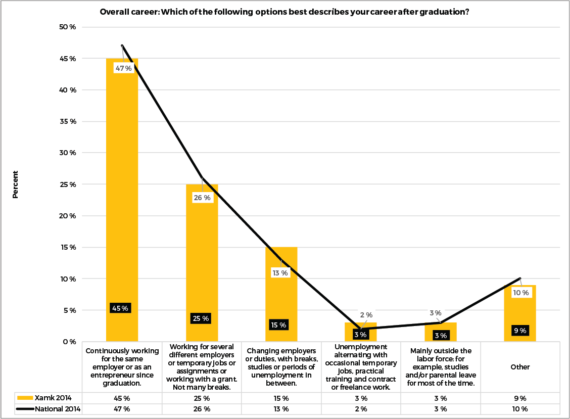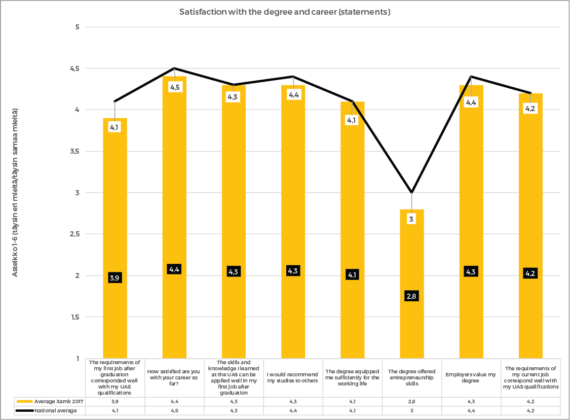The career monitoring survey is sent to students who graduated from a university of applied sciences (UAS) with a bachelor’s or a master’s degree five years earlier. The aim of the survey is to examine the careers and employability of the graduates as well as to explore their satisfaction with their chosen degree. Some questions also measure the quality of employment. These questions determine 3% of the basic funding for universities of applied sciences.
The target group of this survey was 2014 graduates from Kymenlaakso UAS (Kyamk) and Mikkeli UAS (Mamk). A total of 529 answered the national career monitoring survey, and the response rate was 31. The rating scale was 1 = fully disagree, 2 = disagree, 3 = slightly disagree, 4 = slightly agree, 5 = agree, 6 = fully agree.
Most have been working without breaks after graduation
About 70% of the respondents have been working continuously for five years after graduation. Of these respondents, 45% have continuously worked for the same employer. Approximately 25% have worked without breaks for multiple companies, or on a part-time or project basis or with the help of a scholarship.
Only 15% of all the respondents have had multiple temporary jobs, and only 3% had been unemployed for a longer time.
Satisfaction with the degree and career
Altogether 83% of all the respondents were satisfied with their career and 16% were very satisfied. In addition, 73% found that their degree had provided sufficient skills for working life. However, only 32% said that their degree offered a way to become an entrepreneur.
The following results show Kyamk’s and Mamk’s 2014 graduates’ satisfaction with their degree and studies. The list includes the survey statements with the Kyamk/Mamk average on the rating scale 1−6. The chart, in turn, also indicates the national averages for the same statements.
- The requirements of my first job after graduation corresponded well with my UAS qualifications 3.9.
- How satisfied are you with your career so far? 4.4.
- The skills and knowledge I learned at the UAS can be applied well in my first job after graduation 4.3.
- I would recommend my studies to others 4.3.
- The degree equipped me sufficiently for the working life 4.1.
- The degree offered entrepreneurship skills 2.8.
- Employers value my degree 4.3
- The requirements of my current job correspond well with my UAS qualifications 4.4.
National career monitoring survey results also indicated that 76% of the respondents had participated in some type of education. Most of these were courses or short-term studies.
Work situation at the moment
National career monitoring survey also provides information on the work situation of the graduates after five years from graduation. The results on the 2014 graduates showed that the majority, 72%, of the respondents had worked full time, 11% in temporary jobs and 3% in part–time job. The number of entrepreneurs was 4%, and only 2% reported being unemployed and looking for a job.
The next national career monitoring survey for the 2015 Kyamk and Mamk graduates will be conducted in October 2020. The survey will be sent to the respondents via email and SMS. All the national survey results are available at Vipunen, The Statistics Service of the Finnish Education Administration:
https://vipunen.fi/en-gb/polytechnic/Pages/Uraseuranta.aspx or at the website Töissä.fi: https://toissa.fi/home-en-us/ or at the website uraseurannat.fi :Results of the national UAS Career monitorinc survey

